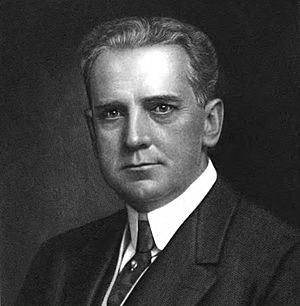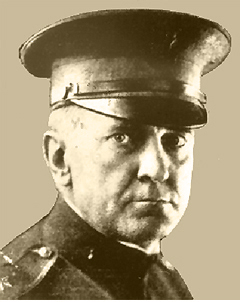Guy Tripp facts for kids
Quick facts for kids
Guy Eastman Tripp
|
|
|---|---|

From Volume 5 (1914) of Biographical History of Massachusetts
|
|
| Chairman of the Westinghouse Electric Corporation Board of Directors | |
| In office January 10, 1912 – June 14, 1927 |
|
| Preceded by | Robert Mather |
| Succeeded by | Samuel M. Vauclain |
| Personal details | |
| Born | April 22, 1864 Wells, Maine |
| Died | June 14, 1927 (aged 62) New York City |
| Resting place | Old Tennent Cemetery, Manalapan Township, New Jersey |
| Spouse | Mary Elaine O'Connell (m. 1887-1927, his death) |
| Children | 3 |
| Education | Berwick Academy, South Berwick, Maine |
| Occupation | Business executive |
| Military service | |
| Allegiance | United States |
| Branch/service | United States Army |
| Years of service | 1917-1918 |
| Rank | Brigadier General |
| Unit | U.S. Army Ordnance Corps |
| Battles/wars | World War I |
| Awards | Army Distinguished Service Medal Order of the Sacred Treasure, Second Class |
Guy Eastman Tripp (born April 22, 1865 – died June 14, 1927) was an important American business leader. He also served as an officer in the United States Army. For many years, he managed and led different companies. From 1912 until he passed away, he was the chairman of the board for the Westinghouse Electric Corporation. Tripp also helped lead more than 20 other companies.
In 1917, Guy Tripp's skills in business and making things were very useful. He was asked to join the United States Army as a major. He helped the Army's Chief of Ordnance, who was in charge of military supplies. In 1918, he was promoted to brigadier general. After World War I, Tripp received the Army Distinguished Service Medal. This award recognized his hard work in helping American factories make war supplies.
Tripp lived in Greenwich, Connecticut and New York City. He died in New York City after having problems from surgery. He was buried at Old Tennent Churchyard in Tennent, New Jersey.
Contents
Guy Tripp's Early Life
Guy Eastman Tripp was born in Wells, Maine on April 22, 1865. His parents were Alonzo R. Tripp and Abbie (Yeaton) Tripp. He went to school in York County. In 1882, he graduated from Berwick Academy in South Berwick, Maine. After finishing school, Tripp moved to Massachusetts. He started working as a clerk for the Eastern Railroad. He stayed in this job until 1890.
Guy Tripp's Business Career
After leaving the Eastern Railroad, Tripp became a clerk for the Thomson-Houston Electric Company. This company was installing a trolley system. These new trolleys replaced the old horse-drawn streetcars in the city. When Thomson-Houston and the Edison Electric Company joined together to form General Electric (GE), Tripp became an auditor for GE. An auditor checks a company's financial records.
In 1895, he became an auditor for the Industrial Improvement Company. This company ran electric street railways in several cities in the Northeastern U.S. These cities included Allentown, Pennsylvania, and Haverhill, Lawrence, and Brockton, Massachusetts.
In 1897, Tripp joined the Stone & Webster engineering company. This company operated city railways in places like Seattle, Dallas, and Houston. Tripp started as a district manager. He worked his way up and eventually became the company's president.
By 1908, the Metropolitan Street Railway System in New York City had financial problems. A special group was created to fix these issues and make the company profitable again. Tripp was hired as an expert to help this group. Soon, he was made the chairman of this group.
After this work was finished in 1912, Tripp became the chairman of the board for the Westinghouse Electric Corporation. He held this important position until he died. Besides his work for Westinghouse Electric, Tripp was also on the boards of directors for over 20 other companies. These included the Westinghouse Lamp Company, New York Railways Company, RCA, Chase National Bank, and the American Sugar Refining Company.
Guy Tripp and World War I
During World War I, the War Department wanted to use Tripp's business and manufacturing skills. In 1917, he joined the United States Army as a major. He was put in charge of the Army's Ordnance Production Division. This division was responsible for making weapons and military supplies. In 1918, Tripp was promoted to brigadier general. He then became an assistant to the Army's Chief of Ordnance.
Tripp served in the Army until the war ended in November 1918. He helped American factories change to making war supplies. For his important work, he received the Army Distinguished Service Medal. President Woodrow Wilson presented him with this award. After leaving the Army, Tripp went back to his business career. However, he continued to give unofficial advice to the War Department. Later, Tripp was honored by being added to the Ordnance Corps Association's Hall of Fame.
Later Career and Achievements
Tripp continued to be the chairman of the board at Westinghouse. He also remained a board member for several other companies. In 1923 and 1924, Tripp traveled around the world. His trip was to build good relationships and help Westinghouse grow its businesses in other countries. He was well-received and earned awards from several foreign governments. One award was Japan's Order of the Sacred Treasure, Second Class. In 1924, he received a special honorary degree (LL.D.) from Bates College in Maine.
Besides his work as a business leader, Tripp also wrote several books and articles for professional journals. Some of his published works include Super-Power as an Aid to Progress (1924) and Electric Development as an Aid to Agriculture (1926).
Death and Burial
In June 1927, Guy Tripp had surgery on his intestines at a New York City hospital. He developed problems after the surgery, which sadly led to his death. He passed away in New York City on June 14, 1927.
Tripp's funeral was held at the Unitarian Church of All Souls in Manhattan. Important people like Charles M. Schwab and Major General Clarence C. Williams were honorary pallbearers. Tripp was buried at Old Tennent Cemetery in Manalapan Township, New Jersey.
Guy Tripp's Family Life
In 1887, Tripp married Mary Elaine O'Connell from Salem, Massachusetts. She was usually known as Elaine. They had three daughters: Mary, Olive, and Adah. Mary Tripp married Clifford Hemphill. Olive Tripp married Nelson Burnes Gatch. Adah was married first to Gordon Fischer and then to Arthur D. Forst.


